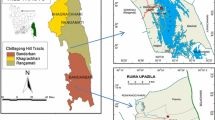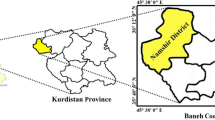Abstract
Natural forests offer numerous benefits to indigenous communities and society at large. Incomes from forest sources play an important role in rural households. In addition to this, environmental sources in the forests contribute significantly to rural households’ livelihoods and economic well-being. This paper examines the contributions of forests to the livelihoods of the Chakma tribe in Bangladesh. Using the data from 60 randomly sampled households from three villages, it measured forest-resource use with a monetary yardstick. As revealed through analyses, natural forest-sourced income occupies the second-largest share in total average household income next to shifting cultivation income in the study area. Forest products represent an important component in the local livelihoods, with a direct forest income of 11,256 tk year−1 household−1 (tk = taka, the national currency of Bangladesh; US$1 = tk70), or 11% of the total income, in addition to the households receiving monetary benefits of 18,951 tk year−1 household−1, or 21% of the total income, through the consumption of forest products. The remaining income came from shifting cultivation practice. It was also observed that larger families with more people gathering forest products realized more forest income. This study will be relevant to forest and environmental policy-makers as well as indigenous community development practitioners.


Similar content being viewed by others
Notes
Local government unit in a district of Bangladesh.
Local government unit in a semi-urban area. This is a municipality at the local level.
Local government unit in a municipality.
Administrative unit below the level of a ward of a municipality.
Local government unit below an Upazila.
Smaller unit below a union, mainly used for land demarcation.
This is a domestic unit consisting of the members of a family living together along with nonrelatives such as servants. This is the smallest social functional unit in the village.
The data were derived from the latest population census in Bangladesh held in 2001. However, the population in the mentioned area has clearly increased considerably since then.
References
Ahmed AIMU (2008) Underlying causes of deforestation and forest degradation in Bangladesh. Global Forest Coalition (GFC), Amsterdam
Alam MK (2002) Ethnobotanical knowledge and indigenous non-timber food crops for sustainable development of upland farming system in the CHTs. In: Khan NA (ed) Farming practices and sustainable development in Chittagong Hill Tracts. Chittagong Hill Tracts Development Board, Government of Bangladesh/Village and Farm Forestry Project, Swiss Agency for Development and Cooperation, Dhaka, pp 155–163
Babulo B, Muys B, Nega F, Tollens E, Nyssen J, Deckers J, Mathijs E (2009) The economic contribution of forest resource use to rural livelihoods in Tigray, Northern Ethiopia. For Policy Econ 11:109–117
Bahuguna VK (2000) Forests in the economy of the rural poor: an estimation of the dependency level. Ambio 29:126–129
Banik RL (1998) Ethno-botany of bamboo and rattan and their indigenous management and utilization in Chittagong Hill tracts. In: Banik RL, Alam MK, Pei SJ, Rastogi A (eds) Applied ethno-botany. Bangladesh Forest Research Institute, Chittagong, pp 93–102
BBS (2009) Statistical year book of Bangladesh, 28th edn. Bangladesh Bureau of Statistics, Dhaka
Biswas SR, Choudhury JK (2007) Forests and forest management practices in Bangladesh: the question of sustainability. Int For Rev 9:627–640
Bromley DW (2008) Resource degradation in the African commons: accounting for institutional decay. Environ Dev Econ 13:539–563
Chowdhury MSH, Miah MD (2003) Housing pattern and food habit of the Mro-tribe community in Bangladesh: a forest dependence perspective. J For Res 14:253–258
Chowdhury MSH, Halim MA, Miah MD, Muhammed N, Koike M (2007) Biodiversity use through harvesting faunal resources from forests by the Mro tribe in the Chittagong Hill Tracts, Bangladesh. Int J Biodivers Sci Manag 30:56–62
Collier N, Boedhihartono AK, Sayer J (2009) Indigenous livelihoods and the global environment: understanding relationships. In: Anderssen RS, Braddock RD, Newham LT H (eds) 18th IMACS World Congress and MODSIM09 International Congress on Modelling and Simulation. Modelling and Simulation Society of Australia and New Zealand/International Association for Mathematics and Computers in Simulation, Canberra, pp 2833–2839
Dewi S, Belcher B, Puntodewo A (2005) Village economic opportunities, forest dependence, and rural livelihoods in East Kalimantan, Indonesia. World Dev 33:1419–1434
Dhali HH (2008) Deforestation and its impacts on indigenous women: a case from the Chittagong Hill Tracts in Bangladesh. Gend Technol Dev 12:229–246
Guariguata MR, Balvanera P (2009) Tropical forest service flows: improving our understanding of the biophysical dimension of ecosystem services. For Ecol Manag 258:1825–1829
Halim S, Roy RD, Chakma S, Tanchangya SB (2007) Bangladesh: the interface of customary and state laws in the Chittagong Hill Tracts. In: Leake H (ed) Bridging the gap: policies and practices on indigenous peoples’ natural resource management in Asia. UNDP (United National Development Program) RIPP (Regional Indigenous Peoples’ Program)/AIPP (Asia Indigenous Peoples’ Pact) Foundation, Chiang Mai, pp 41–110
Haque M (2000a) Environmental issues and concerns of the indigenous communities of Bangladesh. Grassroots Voice 3:67–75
Haque M (2000b) Indigenous knowledge and practice of the people of the Chittagong Hill Tracts in Bangladesh. In: Khan NA (ed) Of popular wisdom: indigenous knowledge and practices in Bangladesh. BARCIK/IARD, Dhaka, pp 129–134
Hardin G (1968) The tragedy of the commons. Science 162:1243–1248
Iftekhar MS, Hoque AKF (2005) Causes of forest encroachment: an analysis of Bangladesh. GeoJournal 62:95–106
Jana SK, Chauhan AS (2000) Ethno-botanical aspects of legumes in Sikkim. J Non-Timber For Prod 7:46–52
Kamanga P, Vedeld P, Sjaastad E (2009) Forest incomes and rural livelihoods in Chiradzulu District, Malawi. Ecol Econ 68:613–624
Khan NA, Rashid AZMM (2006) A study on the indigenous medicinal plants and healing practices in Chittagong Hill Tracts (Bangladesh). Afr J Tradit Complement Altern Med 3:37–47
Khan S (1997) Parbatya Chattagramer Upajati (in Bengali). Bangla Academy, Dhaka
Khisa SK (1998) Ethno-botanical cultural background of ethnic communities in forest resource management in Chittagong Hill Tracts. In: Banik RL, Alam MK, Pei SJ, Rastogi A (eds) Applied ethno-botany. Bangladesh Forest Research Institute, Chittagong, pp 56–63
Levene M (1999) The Chittagong Hill Tracts: a case study in the political economy of “creeping” genocide. Third World Q 20:339–369
Maikhuri RK, Nautiyal S, Rao KS, Semwal RL (2000) Indigenous knowledge of medicinal plants and wild edibles among three tribal sub-communities of the central Himalayas, India. Indig Knowl Dev Monit 8:7–13
Miah MD, Chowdhury MSH (2003) Indigenous healthcare practice through medicinal plants from forests by the Mro tribe in Bandarban region, Bangladesh. Indilinga 2:59–74
Miah MD, Chowdhury MSH (2004) Traditional forest utilization practice by the Mro tribe in the Bandarban region, Bangladesh. Swiss For J 155:65–70
Namgyel P, Ghimiray AC (1998) Forest the superstore: a case study of rural peoples’ dependence on forest resources in west-central Bhutan. In: Banik RL, Alam MK, Pei SJ, Rastog A (eds) Applied ethno-botany. Bangladesh Forest Research Institute, Chittagong, pp 16–19
Nath TK, Inoue M (2009) Forest-based settlement project and its impacts on community livelihood in the Chittagong Hill Tracts, Bangladesh. Int For Rev 11:394–407
Nath TK, Inoue M (2010) Impacts of participatory forestry on livelihoods of ethnic people: experience from Bangladesh. Soc Nat Resour 23:1093–1107
Nath TK, Inoue M, Chakma S (2005) Shifting cultivation (jhum) in the Chittagong Hill Tracts, Bangladesh: examining its sustainability, rural livelihood and policy implications. Int J Agric Sustain 3:130–142
ODC (Office of the Deputy Commissioner) (2011) Rangamati District information. Rangamati District Administration, Rangamati. http://www.dcrangamati.gov.bd
Prain D (1981) Bengal plants. Bishen Singh Mahendra Pal Singh, Dehra Dun
Rasul G (2007) Political ecology of the degradation of forest commons in the Chittagong Hill Tracts of Bangladesh. Environ Conserv 34:153–163
Rasul G, Thapa GB, Zoebisch MA (2004) Determinants of land-use changes in the Chittagong Hill Tracts of Bangladesh. Appl Geogr 24:217–240
Rist S, Dahdouh-Guebas F (2006) Ethnosciences—a step towards the integration of scientific and indigenous forms of knowledge in the management of natural resources for the future. Environ Dev Sustain 8:467–493
Rodriguez LG, Pérez MR, Yang X, Fu M, Geriletu WuD (2009) Changing contribution of forests to livelihoods: evidence from Daxi Village, Zhejiang Province, China. Int For Rev 11:319–330
Salam M, Noguchi T, Koike M (1999) The causes of forest cover loss in the hill forests in Bangladesh. GeoJournal 47:539–549
Samal J (1997) Role of forest in a poor resource base tribal economy: a micro analysis. In: Mohapatra PM, Mohapatro PC (eds) Forest management in tribal areas. Concept, New Delhi, pp 105–124
Shackleton CM, Shackleton SE, Buiten E, Bird N (2007) The importance of dry woodlands and forests in rural livelihoods and poverty alleviation in South Africa. For Policy Econ 9:558–577
Shroff J (1997) Forest policy and tribal development. In: Mohapatra PM, Pohapatra PC (eds) Forest management in tribal areas. Concept, New Delhi, pp 65–69
Thapa GB, Rasul G (2006) Implications of changing national policies on land use in the Chittagong Hill Tracts of Bangladesh. J Environ Manag 81:441–453
Author information
Authors and Affiliations
Corresponding author
About this article
Cite this article
Miah, M.D., Chakma, S., Koike, M. et al. Contribution of forests to the livelihood of the Chakma community in the Chittagong Hill Tracts of Bangladesh. J For Res 17, 449–457 (2012). https://doi.org/10.1007/s10310-011-0317-y
Received:
Accepted:
Published:
Issue Date:
DOI: https://doi.org/10.1007/s10310-011-0317-y




